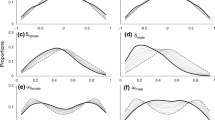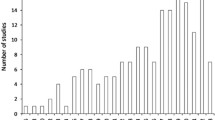Abstract
Studies of phenotypic plasticity have emphasized the effect of the environment on the phenotype, but plasticity can also be used as a tool to study the functional significance of key traits. By inducing variation in phenotypes and testing quantitative models that predict performance based on biological mechanisms, we can develop functionally general models of performance. Pumpkinseed sunfish from lakes with high snail availability have large levator posterior muscles (which are used to crush snail shells), whereas fish from lakes with few snails have relatively small muscles. Here we: (1) quantify differences in the feeding ability of an ontogenetic series of pumpkinseed from two populations; and (2) evaluate whether a biomechanical model can resolve the observed ontogenetic and between-population variation in feeding ecology. Mass, but not length, of the levator posterior muscle in fish from Three Lakes (a lake rich in snails) was greater than for comparably sized fish from Wintergreen Lake (a lake with few snails). Handling times were shorter, crushing strengths were 71% greater, and foraging rate (snail tissue mass consumed per time) and the fraction of thick-shelled snails in the diet were approximately 100% greater for fish from Three Lakes compared to comparably sized fish from Wintergreen. These between-lake differences were not significant after adjusting for variation in pharyngeal morphology, suggesting that the biomechanical model of snail crushing resolved observed ontogenetic and population-level variation in the feeding ecology of pumpkinseed.








Similar content being viewed by others
References
Altringham JD, Johnston IA (1982) The pCa-tension and force-velocity characteristics of skinned fibers isolated from fish fast and slow muscle. J Physiol 333:421–449
Arnold SJ (1983) Morphology, performance and fitness. Am Zool 23:347–361
Brönmark C, Miner JG (1992) Predator-induced phenotypical change in body morphology in crucian carp. Science 258:1348–1350
Calow LJ, Alexander R (1973) A mechanical analysis of a hind leg of a frog (Rana temporaria). J Zool 171:293–321
Dunham A, Beaupre SJ (1998) Ecological experiments: scale, phenomenology, mechanism, and the illusion of generality. In: Resetarits WJ Jr, Bernardo J (eds) Experimental ecology: issues and perspectives. Oxford University Press, New York, pp 27–49
Emerson SB, Arnold SJ (1989) Intra- and interspecific relationships between morphology, performance and fitness. In: Wake DB, Roth G (eds) Complex organismal functions: integration and evolution in vertebrates. Wiley, New York, pp 295–314
Ferry-Graham LA, Lauder GV (2001) Aquatic prey capture in ray-finned fishes: a century of progress and new directions. J Morphol 248:99–119
Galis F, Drucker EG (1996) Pharyngeal biting mechanics in centrarchid and cichlid fishes: insights into a key evolutionary innovation. J Evol Biol 9:641–670
Havel J (1986) Predator-induced defenses: a review. In: Kerfoot WC, Sih A (eds) Predation: direct and indirect impacts on aquatic communities. University Press of New England, Hanover, pp 263–278
Holling CS (1959) Some characteristics of simple types of predation and parasitism. Can Entomol 91:385–398
Huckins CJF (1997) Functional linkages among morphology, feeding performance, diet, and competitive ability in molluscivorous sunfish. Ecology 78:2401–2414
Huckins CJF, Osenberg CW, Mittelbach GG (2000) Species introductions and ecological consequences: an example with congeneric sunfish. Ecol Appl 10:612–625
Huey RB, Stevenson RD (1979) Integrating thermal physiology and ecology of ectotherms: a discussion of approaches. Am Zool 19:357–366
Johnston IA, Salamonski J (1984) Power output and force-velocity relationship of red and white muscle fibers from the Pacific blue marlin (Makria nigricans). J Exp Biol 111:171–177
Keast A (1978) Feeding interrelations between age-groups of pumpkinseed Lepomis gibbosus and comparisons with bluegill L. macrochirus. J Fish Res Board Can 35:12–27
Lauder GV (1983a) Functional and morphological bases of trophic specialization in sunfishes (Teleostei, Centrarchidae). J Morphol 178:1–21
Lauder GV (1983b) Neuromuscular pattern and the origin of trophic specialization in fishes. Science 219:1235–1236
Lauder GV (1986) Homology, analogy and the evolution of behavior. In: Nitecki MH, Kitchell JA (eds) Evolution of animal behavior. Oxford University Press, New York, pp 9–40
Lowndes AG (1955) Density of fishes. Some notes on the swimming of fish to be correlated with density, sinking factor and the load carried. Ann Mag Nat Hist 8:241–256
Mittelbach GG (1984) Predation and resource partitioning in two sunfishes (Centrarchidae). Ecology 65:499–513
Mittelbach GG, Osenberg CW, Wainwright PC (1992) Variation in resource abundance affects diet and feeding morphology in the pumpkinseed sunfish (Lepomis gibbosus). Oecologia 90:8–13
Mittelbach GG, Osenberg CW, Wainwright PC (1999) Variation in feeding morphology between pumpkinseed populations: phenotypic plasticity or evolution? Evol Ecol Res 1:111–128
Motta PJ, Kotrschal KM (1992) Correlative, experimental, and comparative evolutionary approaches in ecomorphology. Neth J Zool 42:400–415
Motta PJ, Norton SF, Luczkovich JJ (1995) Perspectives on the ecomorphology of bony fishes. Environ Biol Fish 44:11–20
Murdoch WW, Briggs CJ, Nisbet RM (2003) Consumer-resource dynamics. Princeton University Press, Princeton, N.J.
Osenberg CW, Mittelbach GG (1989) Effects of body size on the predator-prey interaction between pumpkinseed sunfish and gastropods. Ecol Monogr 59:405–432
Osenberg CW, Mittelbach GG, Wainwright PC (1992) Two-stage life histories in fish: the interaction between juvenile competition and adult performance. Ecology 73:255–267
Powell PL, Roy RR, Kanim P, Bello MA, Edgergon V (1984) Predictability of skeletal muscle tension from architectural determinations in guinea pig hindlimbs. J Appl Physiol 57:1721–238
Relyea RA (2001) Morphological and behavioral plasticity of larval anurans in response to different predators. Ecology 82:523–540
Robinson BW, Wilson DS, Margosian AS, Lotito PT (1993) Ecological and morphological differentiation of pumpkinseed sunfish in lakes without bluegill sunfish. Evol Ecol 7:451–464
Tilman D (1982) Resource competition and community structure. Princeton University Press, Princeton, N.J.
Travis J (1994) Evaluating the adaptive role of morphological plasticity. In: Wainwright PC, Reilly SM (eds) Ecological morphology: integrative organismal biology. University of Chicago Press, Chicago, Ill., pp 99–122
Turner AM (1996) Freshwater snails alter habitat use in response to predation. Anim Behav 51:747–756
Van Buskirk J, Schmidt BR (2000) Predator-induced phenotypic plasticity in larval newts: tradeoffs, selection, and variation in nature. Ecology 81:3009–3028
Via S, Gomulkiewicz R, De Jong G, Scheiner SM, Schlichting CD, Van Tienderen PH (1995) Adaptive phenotypic plasticity: consensus and controversy. Trends Ecol Evol 10:212–217
Wainwright PC (1987) Biomechanical limits to ecological performance: Mollusc-crushing by the Caribbean hogfish, Lachnolaimus maximus (Labridae). J Zool 213:283–297
Wainwright PC (1991) Ecomorphology: experimental functional anatomy for ecological problems. Am Zool 31:680–693
Wainwright PC (1995) Ecological explanation through functional morphology: the feeding biology of sunfishes. Ecology 77:1336–1343
Wainwright PC, Lauder GV (1986) Feeding biology of sunfishes: patterns of variation in the feeding mechanism. Zool J Linn Soc 88:217–228
Wainwright PC, Reilly SM (1994) Ecological morphology: integrative organismal biology. University of Chicago Press, Chicago, Ill.
Wainwright PC, Osenberg CW, Mittelbach GG (1991) Trophic polymorphism in the pumpkinseed sunfish (Lepomis gibbosus Linnaeus): effects of environment on ontogeny. Funct Ecol 5:40–55
Werner EE (1974) The fish size, prey size, handling time relation in several sunfishes and some implications. J Fish Res Board Can 31:1531–1536
Wimberger PH (1994) Trophic polymorphisms, plasticity, and speciation in vertebrates. University of South Carolina Press, Columbia, S.C.
Acknowledgements
We appreciate useful discussions with Gary Mittelbach and Peter Wainwright as well as the comments of two anonymous reviewers. We also thank Peter Wainwright and Bart Richards for measurements of levator posterior mass and fiber length, and Colette St. Mary for reading a previous draft. This research was supported by an REU supplement from the Ecology Program of NSF, and is contribution no. 1141 of the Kellogg Biological Station. All aspects of this study were conducted in compliance with the laws governing Hickory Corners, Michigan and other locales in which the authors conducted their work.
Author information
Authors and Affiliations
Corresponding author
Rights and permissions
About this article
Cite this article
Osenberg, C.W., Huckins, C.J.F., Kaltenberg, A. et al. Resolving within- and between-population variation in feeding ecology with a biomechanical model. Oecologia 141, 57–65 (2004). https://doi.org/10.1007/s00442-004-1650-z
Received:
Accepted:
Published:
Issue Date:
DOI: https://doi.org/10.1007/s00442-004-1650-z




